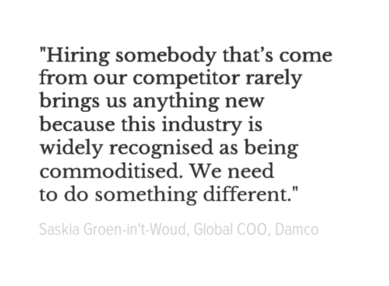How logistics giant Damco righted an ailing ship
In Leaders Talk HR, HRM Magazine Asia sits down with C-suite movers and shakers to talk HR and leadership.

When Saskia Groen-in’t-Woud joined Damco as its Chief Operating Officer in Asia towards the end of 2015, the international logistics business was not in the greatest shape. That year, the headlines seemed to herald only doom and gloom for the company, which had formed two years earlier when Damco Sea & Air merged with Maersk Logistics.
“Maersk spending millions to keep struggling Damco afloat,” trade journal ShippingWatch declared in June, 2015, while another UK-based publication warned “more pain” was on the way.
But a $490 million deficit in 2014 turned into profits from 2016 onwards, and for her role in the turnaround, Groen-in’t-Woud was recognised with the 2017 Telstra Business Woman in Asia Award. She has also levelled up within Damco, and ascended to the post of Global Chief Operating Officer at the end of last year.
“It was an interesting process [being interviewed at the awards ceremony] to go back and remember all those different things that helped me to be where I am today,” she says. “You remember those big moments that stood out that were either horrendously difficult or really rewarding – or both.”
Groen-in’t-Woud has had her fair share of those difficult and rewarding moments, having started out as a small business owner prior to joining the corporate world. Moving to a supply chain management and freight forwarding solutions company might seem like an incredible leap, but Groen-in’t-Woud’s philosophy of hands-on leadership has proved relevant in both good times and bad.
“I’m not a big believer in sending out an email saying, ‘You need to do this.’ I think real change and ownership come from doing and sharing,” she says. “We have an internal Yammer site that I’m very active on. As soon as we’re doing things that we think other people can learn and benefit from, we put it on there.”
These active lines of communication feed into a key point in Groen-in’t-Woud’s approach to leadership: namely, that leaders can’t lead – and produce results – without a clear understanding of the people they are leading, and what those people need to do their jobs.
After all, she notes, if the employees feel supported and motivated, “you can see it in the customer accounts.”
What does a typical day for you look like?
An average day is around touching base with my boss, and with my peers at many levels.
I think one of the most powerful things you can do as a leader is make sure you’ve got touch points at many different levels in a business.
These can act as sounding boards, but also help in message testing – “do I understand this the same way they understand it”?
What challenges does the logistics industry face right now?
We have to almost reinvent the industry, to a degree, around our customer needs.
The only way to succeed in the logistics industry is to understand very clearly what parts of the market you are going to play, and what your value proposition is.
That’s where technology and disruption are having a very big impact – that is, digitisation, automation, and especially blockchain, which is getting a lot of attention in the market.
It requires a well-synced leadership team to understand where technology is relevant, where it’s not, and how to maintain focus and at the same time, the right amount of agility to move with the times.
How does the move towards these technologies affect the workforce?
Digitisation and automation should allow us to free up a lot more time to focus on customer sensitivity. As an industry, we could be a lot more proactive in helping customers manage their shipments, and be agile in managing their needs.
We are committed to retraining. We need to look at people in terms of the knowledge and depth that they have in the industry, and then understand if they are the right fit for that role or if there is somewhere else that we can better place them. The industry is so broad that there are almost always options to make things happen.
I also believe that we need to look for more of the ‘soft’ skills. In customer service, for example, we need to look for people who have been trained by companies like Starbucks, which are famous for their customer service mindset.
We also need to sit next to people and really understand how they do their job.
Recently, I did that in Malaysia, and when one employee answered the phone, he literally said only “Damco.”
I said, “Wow, your name’s Damco?” He replied: “No, my name’s Ishmael.”
“Why don’t you answer the phone and say, ‘Good morning. It’s Ishmael’,” I then suggested. It’s those conversations that, as leaders, you only know by sitting next to people. You also experience their pain points first hand.
Navigating Damco’s turnaround
How does workforce diversity help Damco to keep up with that changing business landscape?
There is gender diversity, but also diversity of thought. You will not get thought diversity by just hiring people with the same backgrounds and experiences.
Hiring somebody that’s come from our competitor rarely brings us anything new because this industry is widely recognised as being commoditised.
We need to do something different. You’re only going to do that by getting people onboard who can bring a new perspective and by creating space for your people to bring their best ideas forward.
You were a part of Damco’s financial turnaround. What were your leadership priorities during that time?
Coming from the outside, I brought discipline in thinking. It was also about recognising the levers we weren’t pulling – procurement was a big one.
Procurement is one of the most unsung heroes in really driving bottom line performance. I brought a great guy from India into the procurement function in Asia, and then we found that due to changes in the business, his spend under management had shrunk, and technically his target should have shrunk.
But I sat down with him and said, “We’re not going to change your target because I know you can find other ways to reach it.” And he not only reached it, he went past it – by looking outside the box and starting to test his own thinking. It wouldn’t have happened if we’d just agreed to reduce his targets.
When we said “this is what we need”, and gave people the space to figure out how to execute those needs, the amount of different ways people came back with how to do that was huge.
That said, there’s only so far you can squeeze the lemon without starting to give people a lot more support in terms of the tools they work with, and the processes they work with.
Leadership approach
What do you see as the essential leadership qualities for surviving and thriving in the logistics industry?
It’s about the ability to look five years down the track; how the decisions we’re making today are going to influence where we’re going to be in five years’ time.
If we keep looking at exactly where we are and how we do things today – and most of the industry has this challenge as well – we’re only going to incrementally improve that. We’re not really doing anything different.
I think you have to believe in the industry, to know your customers and their needs really well, and then make decisions that will take you in the direction that their needs are going in over the next five years. Damco really has embraced this concept.
What do you look for when hiring leaders?
A very wise man taught me about five specific criteria: heart, smarts, courage, change, and character.
You’ve got to have a passion and interest in what you’re doing; you’ve got to have a decent level of intelligence to be able to do the work; you’ve got to have integrity and courage.
That one, for me, comes first – to be able to make the right decisions at the right time, and stand by them. And then the next one is adaptability. People have got to be able to change. This world is moving very, very fast.
And then character is also important. Is this somebody I’d have dinner with? Is this a person that we could have a barbecue with as a team? How would they fit into the broader team dynamic?
What advice would you give to other women who aspire to leadership roles?
Get as much exposure to different elements of the business as possible. Be able to understand, even if you’re in operations or finance, or HR, how customers work, and what customers are looking for.
Being able to have that insight into what’s happening into the business is key, and then to learn, learn, learn, learn, learn!
Always put your hand up for stretch assignments.





